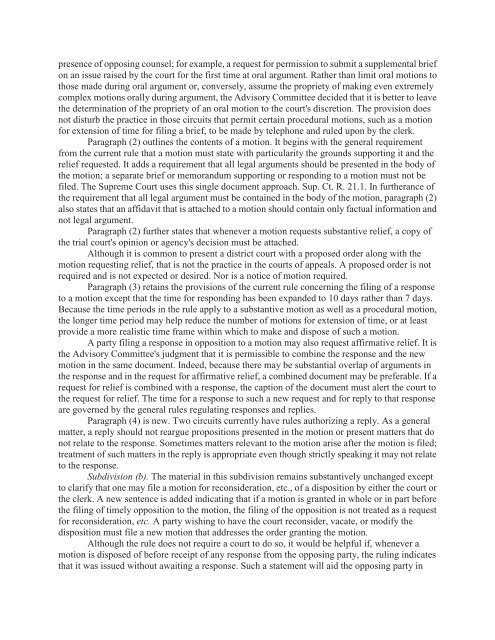Federal Rules of Appellate Procedure 2014-2015, 2014a
Federal Rules of Appellate Procedure 2014-2015, 2014a
Federal Rules of Appellate Procedure 2014-2015, 2014a
You also want an ePaper? Increase the reach of your titles
YUMPU automatically turns print PDFs into web optimized ePapers that Google loves.
presence <strong>of</strong> opposing counsel; for example, a request for permission to submit a supplemental brief<br />
on an issue raised by the court for the first time at oral argument. Rather than limit oral motions to<br />
those made during oral argument or, conversely, assume the propriety <strong>of</strong> making even extremely<br />
complex motions orally during argument, the Advisory Committee decided that it is better to leave<br />
the determination <strong>of</strong> the propriety <strong>of</strong> an oral motion to the court's discretion. The provision does<br />
not disturb the practice in those circuits that permit certain procedural motions, such as a motion<br />
for extension <strong>of</strong> time for filing a brief, to be made by telephone and ruled upon by the clerk.<br />
Paragraph (2) outlines the contents <strong>of</strong> a motion. It begins with the general requirement<br />
from the current rule that a motion must state with particularity the grounds supporting it and the<br />
relief requested. It adds a requirement that all legal arguments should be presented in the body <strong>of</strong><br />
the motion; a separate brief or memorandum supporting or responding to a motion must not be<br />
filed. The Supreme Court uses this single document approach. Sup. Ct. R. 21.1. In furtherance <strong>of</strong><br />
the requirement that all legal argument must be contained in the body <strong>of</strong> the motion, paragraph (2)<br />
also states that an affidavit that is attached to a motion should contain only factual information and<br />
not legal argument.<br />
Paragraph (2) further states that whenever a motion requests substantive relief, a copy <strong>of</strong><br />
the trial court's opinion or agency's decision must be attached.<br />
Although it is common to present a district court with a proposed order along with the<br />
motion requesting relief, that is not the practice in the courts <strong>of</strong> appeals. A proposed order is not<br />
required and is not expected or desired. Nor is a notice <strong>of</strong> motion required.<br />
Paragraph (3) retains the provisions <strong>of</strong> the current rule concerning the filing <strong>of</strong> a response<br />
to a motion except that the time for responding has been expanded to 10 days rather than 7 days.<br />
Because the time periods in the rule apply to a substantive motion as well as a procedural motion,<br />
the longer time period may help reduce the number <strong>of</strong> motions for extension <strong>of</strong> time, or at least<br />
provide a more realistic time frame within which to make and dispose <strong>of</strong> such a motion.<br />
A party filing a response in opposition to a motion may also request affirmative relief. It is<br />
the Advisory Committee's judgment that it is permissible to combine the response and the new<br />
motion in the same document. Indeed, because there may be substantial overlap <strong>of</strong> arguments in<br />
the response and in the request for affirmative relief, a combined document may be preferable. If a<br />
request for relief is combined with a response, the caption <strong>of</strong> the document must alert the court to<br />
the request for relief. The time for a response to such a new request and for reply to that response<br />
are governed by the general rules regulating responses and replies.<br />
Paragraph (4) is new. Two circuits currently have rules authorizing a reply. As a general<br />
matter, a reply should not reargue propositions presented in the motion or present matters that do<br />
not relate to the response. Sometimes matters relevant to the motion arise after the motion is filed;<br />
treatment <strong>of</strong> such matters in the reply is appropriate even though strictly speaking it may not relate<br />
to the response.<br />
Subdivision (b). The material in this subdivision remains substantively unchanged except<br />
to clarify that one may file a motion for reconsideration, etc., <strong>of</strong> a disposition by either the court or<br />
the clerk. A new sentence is added indicating that if a motion is granted in whole or in part before<br />
the filing <strong>of</strong> timely opposition to the motion, the filing <strong>of</strong> the opposition is not treated as a request<br />
for reconsideration, etc. A party wishing to have the court reconsider, vacate, or modify the<br />
disposition must file a new motion that addresses the order granting the motion.<br />
Although the rule does not require a court to do so, it would be helpful if, whenever a<br />
motion is disposed <strong>of</strong> before receipt <strong>of</strong> any response from the opposing party, the ruling indicates<br />
that it was issued without awaiting a response. Such a statement will aid the opposing party in


















